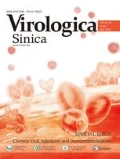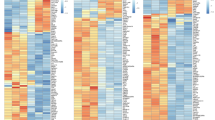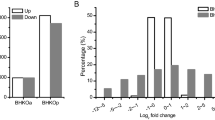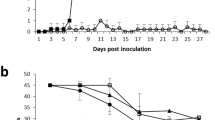Abstract
Foot-and-mouth disease virus (FMDV) is the causative agent of a highly contagious disease in livestock. The viral proteinase Lpro of FMDV is involved in pathogenicity, and mutation of the Lpro SAP domain reduces FMDV pathogenicity in pigs. To determine the gene expression profiles associated with decreased pathogenicity in porcine cells, we performed transcriptome analysis using next-generation sequencing technology and compared differentially expressed genes in SK6 cells infected with FMDV containing Lpro with either a wild-type or mutated version of the SAP domain. This analysis yielded 1,853 genes that exhibited a ≥ 2-fold change in expression and was validated by real-time quantitative PCR detection of several differentially expressed genes. Many of the differentially expressed genes correlated with antiviral responses corresponded to genes associated with transcription factors, immune regulation, cytokine production, inflammatory response, and apoptosis. Alterations in gene expression profiles may be responsible for the variations in pathogenicity observed between the two FMDV variants. Our results provided genes of interest for the further study of antiviral pathways and pathogenic mechanisms related to FMDV Lpro.

Article PDF
Similar content being viewed by others
References
Ahn JS, Whitby MC. 2003. The role of the SAP motif in promoting Holliday junction binding and resolution by SpCCE1. J Biol Chem, 278: 29121–29129.
Alexandersen S, Zhang Z, Donaldson AI, Garland AJ. 2003. The pathogenesis and diagnosis of foot-and-mouth disease. J Comp Pathol, 129: 1–36.
Aravind L, Koonin EV. 2000. SAP-a putative DNA-binding motif involved in chromosomal organization. Trends Biochem Sci, 25: 112–114.
Audic S, Claverie JM. 1997. The significance of digital gene expression profiles. Genome Res, 7: 986–995.
Barasa M, Catley A, Machuchu D, Laqua H, Puot E, Tap KD, Ikiror D. 2008. Foot-and-mouth disease vaccination in South Sudan: benefit-cost analysis and livelihoods impact. Transbound Emerg Dis, 55: 339–351.
Bohm F, Kappes F, Scholten I, Richter N, Matsuo H, Knippers R, Waldmann T. 2005. The SAF-box domain of chromatin protein DEK. Nucleic Acids Res, 33: 1101–1110.
Cheyssac C, Dina C, Lepretre F, Vasseur-Delannoy V, Dechaume A, Lobbens S, Balkau B, Ruiz J, Charpentier G, Pattou F, Joly E, Prentki M, Hansen T, Pedersen O, Vaxillaire M, Froguel P. 2006. EIF4A2 is a positional candidate gene at the 3q27 locus linked to type 2 diabetes in French families. Diabetes, 55: 1171–1176.
Chinsangaram J, Mason PW, Grubman MJ. 1998. Protection of swine by live and inactivated vaccines prepared from a leader proteinase-deficient serotype A12 foot-and-mouth disease virus. Vaccine, 16: 1516–1522.
Clarke BE, Sangar DV, Burroughs JN, Newton SE, Carroll AR, Rowlands DJ. 1985. Two initiation sites for foot-and-mouth disease virus polyprotein in vivo. J Gen Virol, 66: 2615–2626.
de Los Santos T, Diaz-San Segundo F, Grubman MJ. 2007. Degradation of nuclear factor kappa B during foot-and-mouth disease virus infection. J Virol, 81: 12803–12815.
de Los Santos T, Diaz-San Segundo F, Zhu J, Koster M, Dias CC, Grubman MJ. 2009. A conserved domain in the leader proteinase of foot-and-mouth disease virus is required for proper subcellular localization and function. J Virol, 83: 1800–1810.
de Los ST, de Avila BS, Weiblen R, Grubman MJ. 2006. The leader proteinase of foot-and-mouth disease virus inhibits the induction of beta interferon mRNA and blocks the host innate immune response. J Virol, 80: 1906–1914.
Devaney MA, Vakharia VN, Lloyd RE, Ehrenfeld E, Grubman MJ. 1988. Leader protein of foot-and-mouth disease virus is required for cleavage of the p220 component of the cap-binding protein complex. J Virol, 62: 4407–4409.
Diaz-San Segundo F, Weiss M, Perez-Martin E, Dias CC, Grubman MJ, de Los Santos T. 2012. Inoculation of swine with footand-mouth disease SAP-mutant virus induces early protection against disease. J Virol, 86: 1316–1327.
Dienz O, Rud JG, Eaton SM, Lanthier PA, Burg E, Drew A, Bunn J, Suratt BT, Haynes L, Rincon M. 2012. Essential role of IL-6 in protection against H1N1 influenza virus by promoting neutrophil survival in the lung. Mucosal Immunol, 5: 258–266.
ElAntak L, Tzakos AG, Locker N, Lukavsky PJ. 2007. Structure of eIF3b RNA recognition motif and its interaction with eIF3j: structural insights into the recruitment of eIF3b to the 40 S ribosomal subunit. J Biol Chem, 282: 8165–8174.
Grubman MJ, Moraes MP, Diaz-San Segundo F, Pena L, de Los Santos T. 2008. Evading the host immune response: how footand- mouth disease virus has become an effective pathogen. FEMS Immunol Med Microbiol, 53: 8–17.
Han H, Xue-Franzen Y, Miao X, Nagy E, Li N, Xu D, Sjoberg J, Bjorkholm M, Claesson HE. 2015. Early growth response gene (EGR)-1 regulates leukotriene D4-induced cytokine transcription in Hodgkin lymphoma cells. Prostaglandins Other Lipid Mediat, 121: 122–130.
Kanehisa M, Araki M, Goto S, Hattori M, Hirakawa M, Itoh M, Katayama T, Kawashima S, Okuda S, Tokimatsu T, Yamanishi Y. 2008. KEGG for linking genomes to life and the environment. Nucleic Acids Res, 36: D480–D484.
Kipp M, Gohring F, Ostendorp T, van Drunen CM, van Driel R, Przybylski M, Fackelmayer FO. 2000. SAF-Box, a conserved protein domain that specifically recognizes scaffold attachment region DNA. Mol Cell Biol, 20: 7480–7489.
Kirchweger R, Ziegler E, Lamphear BJ, Waters D, Liebig HD, Sommergruber W, Sobrino F, Hohenadl C, Blaas D, Rhoads RE, Et A. 1994. Foot-and-mouth disease virus leader proteinase: purification of the Lb form and determination of its cleavage site on eIF-4 gamma. J Virol, 68: 5677–5684.
Kyono K, Miyashiro M, Taguchi I. 2002. Human eukaryotic initiation factor 4AII associates with hepatitis C virus NS5B protein in vitro. Biochem Biophys Res Commun, 292: 659–666.
Li R, Li Y, Kristiansen K, Wang J. 2008. SOAP: short oligonucleotide alignment program. Bioinformatics, 24: 713–714.
Medina M, Domingo E, Brangwyn JK, Belsham GJ. 1993. The two species of the foot-and-mouth disease virus leader protein, expressed individually, exhibit the same activities. Virology, 194: 355–359.
Meijer HA, Kong YW, Lu WT, Wilczynska A, Spriggs RV, Robinson SW, Godfrey JD, Willis AE, Bushell M. 2013. Translational repression and eIF4A2 activity are critical for microRNA-mediated gene regulation. Science, 340: 82–85.
Mortazavi A, Williams BA, McCue K, Schaeffer L, Wold B. 2008. Mapping and quantifying mammalian transcriptomes by RNA-Seq. Nat Methods, 5: 621–628.
Ninomiya-Tsuji J, Kishimoto K, Hiyama A, Inoue J, Cao Z, Matsumoto K. 1999. The kinase TAK1 can activate the NIK-I kappaB as well as the MAP kinase cascade in the IL-1 signalling pathway. Nature, 398: 252–256.
Pega J, Bucafusco D, Di Giacomo S, Schammas JM, Malacari D, Capozzo AV, Arzt J, Perez-Beascoechea C, Maradei E, Rodriguez LL, Borca MV, Perez-Filgueira M. 2013. Early adaptive immune responses in the respiratory tract of foot-and-mouth disease virus-infected cattle. J Virol, 87: 2489–2495.
Perry BD, Rich KM. 2007. Poverty impacts of foot-and-mouth disease and the poverty reduction implications of its control. Vet Rec, 160: 238–241.
Piccone ME, Rieder E, Mason PW, Grubman MJ. 1995. The footand-mouth disease virus leader proteinase gene is not required for viral replication. J Virol, 69: 5376–5382.
Piccone ME, Zellner M, Kumosinski TF, Mason PW, Grubman MJ. 1995. Identification of the active-site residues of the L proteinase of foot-and-mouth disease virus. J Virol, 69: 4950–4956.
Racaniello VR. 2007. Picornaviridae: The Viruses and Their Replication. In: Fields virology (5th ed). Philadelphia: Lippin-cott-Raven, pp. 795–948.
Reed LJ, Muench H. 1938. A simple method of estimating fifty percent endpoints. American journal of epidemiology, 27: 493–497.
Rufael T, Catley A, Bogale A, Sahle M, Shiferaw Y. 2008. Foot and mouth disease in the Borana pastoral system, southern Ethiopia and implications for livelihoods and international trade. Trop Anim Health Prod, 40: 29–38.
Ruggli N, Tratschin JD, Schweizer M, McCullough KC, Hofmann MA, Summerfield A. 2003. Classical swine fever virus interferes with cellular antiviral defense: evidence for a novel function of N(pro). J Virol, 77: 7645–7654.
Unbehaun A, Marintchev A, Lomakin IB, Didenko T, Wagner G, Hellen CU, Pestova TV. 2007. Position of eukaryotic initiation factor eIF5B on the 80S ribosome mapped by directed hydroxyl radical probing. EMBO J, 26: 3109–3123.
Wang D, Fang L, Luo R, Ye R, Fang Y, Xie L, Chen H, Xiao S. 2010. Foot-and-mouth disease virus leader proteinase inhibits dsRNA-induced type I interferon transcription by decreasing interferon regulatory factor 3/7 in protein levels. Biochem Biophys Res Commun, 399: 72–78.
Yamazaki S, Muta T, Takeshige K. 2001. A novel IkappaB protein, IkappaB-zeta, induced by proinflammatory stimuli, negatively regulates nuclear factor-kappaB in the nuclei. J Biol Chem, 276: 27657–27662.
Zheng H, Guo J, Jin Y, Yang F, He J, Lv L, Zhang K, Wu Q, Liu X, Cai X. 2013. Engineering foot-and-mouth disease viruses with improved growth properties for vaccine development. PLoS One, 8: e55228.
Zhu J, Weiss M, Grubman MJ, de Los Santos T. 2010. Differential gene expression in bovine cells infected with wild type and leaderless foot-and-mouth disease virus. Virology, 404: 32–40.
Author information
Authors and Affiliations
Corresponding authors
Additional information
These authors contributed equally to this work.
ORCID: 0000-0002-4093-9683
ORCID: 0000-0001-6850-1379
Electronic supplementary material
Rights and permissions
About this article
Cite this article
Ni, Z., Yang, F., Cao, W. et al. Differential gene expression in porcine SK6 cells infected with wild-type and SAP domain-mutant foot-and-mouth disease virus. Virol. Sin. 31, 249–257 (2016). https://doi.org/10.1007/s12250-015-3709-x
Received:
Accepted:
Published:
Issue Date:
DOI: https://doi.org/10.1007/s12250-015-3709-x




